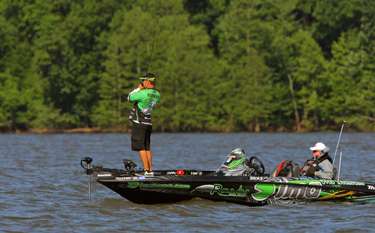
Had the boys in Aerosmith been avid bass anglers instead of musicians, their ode to teenage promiscuity might have gone a little differently. Instead of “Walk this way, talk this way,” we might have heard: “Walk this way, pop this way.” As it stands, the aging rockers will teach us little about topwater tactics. Hence, we turn to Bassmaster Elite Series pro Fred Roumbanis.
Narrowing down a rather broad topic into a two-pronged approach, the Oklahoma angler said the question of when to walk and when to pop comes down to quality or quantity. Sure, everyone wants lots of big fish, but in reality, fishing for size and fishing for numbers are usually two different objectives.
For greater big-fish potential, Roumbanis said he’ll walk an Ima Skimmer or Pencil Popper, Heddon Super Spook or his signature series Tru-Tungsten Shad Walker. The key with any of these, he said, is the impersonation of stricken prey.
“The thing about topwater fishing is you really want to make that bait look injured, and walking the dog looks like an injured baitfish on the surface,” Roumbanis said.
Although he’ll work the walker in anywhere from a foot to 50 feet over standing timber, Roumbanis favors wide open spaces with long, tapering points swept by a nice breeze. Likening the bold display of a walking bait to the proverbial dinner bell, he said it announces the opportunity, and it’s this easy-meal imagery that calls in big fish from afar.
“You just run and gun and hit as many points as you can,” he said. “Breeze breaks up the surface visibility and the fish will attack surface baits more. They don’t see the treble hooks as well.”
For Roumbanis, other good walking scenarios include bed fishing and summer afternoons, right when a frontal system rolls into the area.
“When the big cumulus clouds roll in, it pulls the fish away from cover when you get that afternoon shade,” he said. “The fish are more likely to be roaming free. I think the barometric fluctuation also has a lot to do with it — the calm before the storm.”
Now, when he’s playing the numbers game, Roumbanis will break out a Rico popper or a Pop-R and chug it near bass cover like flooded brush, docks or isolated rocks. He always carries Gamakatsu feathered trebles to dress up the bait’s caboose, but he cautions anglers to closely monitor the popping performance, as these accessories can sometimes impede the popper’s action.
Terming the popper more of a “panic box” technique, Roumbanis said he’ll go this route when pressured waters yield a tough bite. “You’re going to get more bites on this, but you won’t necessarily get the biggest.”
As a reactionary move, a popper’s water spitting display equips anglers to take advantage of bass-enticing surface activity like shad popping up or bluegill chowing on a Mayfly hatch.
Roumbanis’ tactical tip: “A lot of times, I’ll throw a frog up in a tree and shake the limbs to make a lot of those bugs fall out, then I’ll throw my bait in there, pop it a couple of times and voilà — largemouth bass.”
For all of his topwater duties, Roumbanis uses an Ardent XS1000 baitcaster on a custom 7-4 medium-heavy rod. He’ll spool his reel with 30- to 40-pound braided line and top it off with 14 inches of 17-pound fluorocarbon leader to keep the bait from grabbing braid on the cast.
Whether it’s the reel-twitch-reel of a walk-the-dog presentation or the twitch-twitch-pause of a popper, Roumbanis believe the common thread is anxiety, or at least the appearance thereof. “Anytime you’re topwater fishing, you always want to make your bait look like it’s scrambling. It’s that panic mode that triggers bass to strike.”





